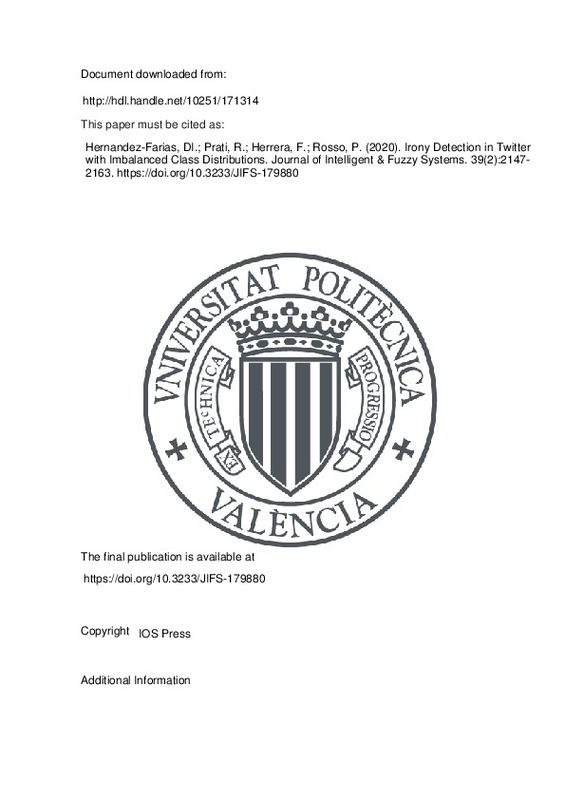Batista, G. E. A. P. A., Prati, R. C., & Monard, M. C. (2004). A study of the behavior of several methods for balancing machine learning training data. ACM SIGKDD Explorations Newsletter, 6(1), 20-29. doi:10.1145/1007730.1007735
Chawla, N. V., Bowyer, K. W., Hall, L. O., & Kegelmeyer, W. P. (2002). SMOTE: Synthetic Minority Over-sampling Technique. Journal of Artificial Intelligence Research, 16, 321-357. doi:10.1613/jair.953
Fernández A. , García S. , Galar M. , Prati R.C. , Krawczyk B. and Herrera F. , Learning from imbalanced data sets, Springer, (2018).
[+]
Batista, G. E. A. P. A., Prati, R. C., & Monard, M. C. (2004). A study of the behavior of several methods for balancing machine learning training data. ACM SIGKDD Explorations Newsletter, 6(1), 20-29. doi:10.1145/1007730.1007735
Chawla, N. V., Bowyer, K. W., Hall, L. O., & Kegelmeyer, W. P. (2002). SMOTE: Synthetic Minority Over-sampling Technique. Journal of Artificial Intelligence Research, 16, 321-357. doi:10.1613/jair.953
Fernández A. , García S. , Galar M. , Prati R.C. , Krawczyk B. and Herrera F. , Learning from imbalanced data sets, Springer, (2018).
Haibo He, & Garcia, E. A. (2009). Learning from Imbalanced Data. IEEE Transactions on Knowledge and Data Engineering, 21(9), 1263-1284. doi:10.1109/tkde.2008.239
Farías, D. I. H., Patti, V., & Rosso, P. (2016). Irony Detection in Twitter. ACM Transactions on Internet Technology, 16(3), 1-24. doi:10.1145/2930663
Japkowicz, N., & Stephen, S. (2002). The class imbalance problem: A systematic study1. Intelligent Data Analysis, 6(5), 429-449. doi:10.3233/ida-2002-6504
Kumon-Nakamura, S., Glucksberg, S., & Brown, M. (1995). How about another piece of pie: The allusional pretense theory of discourse irony. Journal of Experimental Psychology: General, 124(1), 3-21. doi:10.1037/0096-3445.124.1.3
López, V., Fernández, A., García, S., Palade, V., & Herrera, F. (2013). An insight into classification with imbalanced data: Empirical results and current trends on using data intrinsic characteristics. Information Sciences, 250, 113-141. doi:10.1016/j.ins.2013.07.007
Mohammad, S. M., & Turney, P. D. (2012). CROWDSOURCING A WORD-EMOTION ASSOCIATION LEXICON. Computational Intelligence, 29(3), 436-465. doi:10.1111/j.1467-8640.2012.00460.x
Mohammad, S. M., Zhu, X., Kiritchenko, S., & Martin, J. (2015). Sentiment, emotion, purpose, and style in electoral tweets. Information Processing & Management, 51(4), 480-499. doi:10.1016/j.ipm.2014.09.003
Poria, S., Gelbukh, A., Hussain, A., Howard, N., Das, D., & Bandyopadhyay, S. (2013). Enhanced SenticNet with Affective Labels for Concept-Based Opinion Mining. IEEE Intelligent Systems, 28(2), 31-38. doi:10.1109/mis.2013.4
Prati, R. C., Batista, G. E. A. P. A., & Silva, D. F. (2014). Class imbalance revisited: a new experimental setup to assess the performance of treatment methods. Knowledge and Information Systems, 45(1), 247-270. doi:10.1007/s10115-014-0794-3
Reyes, A., Rosso, P., & Veale, T. (2012). A multidimensional approach for detecting irony in Twitter. Language Resources and Evaluation, 47(1), 239-268. doi:10.1007/s10579-012-9196-x
Sulis, E., Irazú Hernández Farías, D., Rosso, P., Patti, V., & Ruffo, G. (2016). Figurative messages and affect in Twitter: Differences between #irony, #sarcasm and #not. Knowledge-Based Systems, 108, 132-143. doi:10.1016/j.knosys.2016.05.035
Utsumi, A. (2000). Verbal irony as implicit display of ironic environment: Distinguishing ironic utterances from nonirony. Journal of Pragmatics, 32(12), 1777-1806. doi:10.1016/s0378-2166(99)00116-2
Whissell, C. (2009). Using the Revised Dictionary of Affect in Language to Quantify the Emotional Undertones of Samples of Natural Language. Psychological Reports, 105(2), 509-521. doi:10.2466/pr0.105.2.509-521
Wilson, D., & Sperber, D. (1992). On verbal irony. Lingua, 87(1-2), 53-76. doi:10.1016/0024-3841(92)90025-e
[-]







![[Cerrado]](/themes/UPV/images/candado.png)


